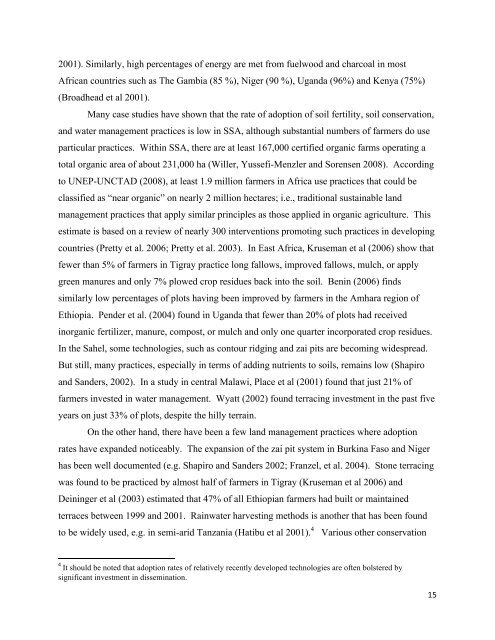The Role of Sustainable Land Management for Climate ... - CAADP
The Role of Sustainable Land Management for Climate ... - CAADP
The Role of Sustainable Land Management for Climate ... - CAADP
Create successful ePaper yourself
Turn your PDF publications into a flip-book with our unique Google optimized e-Paper software.
!<br />
2001). Similarly, high percentages <strong>of</strong> energy are met from fuelwood and charcoal in most<br />
African countries such as <strong>The</strong> Gambia (85 %), Niger (90 %), Uganda (96%) and Kenya (75%)<br />
(Broadhead et al 2001). !<br />
Many case studies have shown that the rate <strong>of</strong> adoption <strong>of</strong> soil fertility, soil conservation,<br />
and water management practices is low in SSA, although substantial numbers <strong>of</strong> farmers do use<br />
particular practices. Within SSA, there are at least 167,000 certified organic farms operating a<br />
total organic area <strong>of</strong> about 231,000 ha (Willer, Yussefi-Menzler and Sorensen 2008). According<br />
to UNEP-UNCTAD (2008), at least 1.9 million farmers in Africa use practices that could be<br />
classified as “near organic” on nearly 2 million hectares; i.e., traditional sustainable land<br />
management practices that apply similar principles as those applied in organic agriculture. This<br />
estimate is based on a review <strong>of</strong> nearly 300 interventions promoting such practices in developing<br />
countries (Pretty et al. 2006; Pretty et al. 2003). In East Africa, Kruseman et al (2006) show that<br />
fewer than 5% <strong>of</strong> farmers in Tigray practice long fallows, improved fallows, mulch, or apply<br />
green manures and only 7% plowed crop residues back into the soil. Benin (2006) finds<br />
similarly low percentages <strong>of</strong> plots having been improved by farmers in the Amhara region <strong>of</strong><br />
Ethiopia. Pender et al. (2004) found in Uganda that fewer than 20% <strong>of</strong> plots had received<br />
inorganic fertilizer, manure, compost, or mulch and only one quarter incorporated crop residues.<br />
In the Sahel, some technologies, such as contour ridging and zai pits are becoming widespread.<br />
But still, many practices, especially in terms <strong>of</strong> adding nutrients to soils, remains low (Shapiro<br />
and Sanders, 2002). In a study in central Malawi, Place et al (2001) found that just 21% <strong>of</strong><br />
farmers invested in water management. Wyatt (2002) found terracing investment in the past five<br />
years on just 33% <strong>of</strong> plots, despite the hilly terrain.<br />
On the other hand, there have been a few land management practices where adoption<br />
rates have expanded noticeably. <strong>The</strong> expansion <strong>of</strong> the zai pit system in Burkina Faso and Niger<br />
has been well documented (e.g. Shapiro and Sanders 2002; Franzel, et al. 2004). Stone terracing<br />
was found to be practiced by almost half <strong>of</strong> farmers in Tigray (Kruseman et al 2006) and<br />
Deininger et al (2003) estimated that 47% <strong>of</strong> all Ethiopian farmers had built or maintained<br />
terraces between 1999 and 2001. Rainwater harvesting methods is another that has been found<br />
to be widely used, e.g. in semi-arid Tanzania (Hatibu et al 2001). 4 Various other conservation<br />
!!!!!!!!!!!!!!!!!!!!!!!!!!!!!!!!!!!!!!!!!!!!!!!!!!!!!!!!!!!!!<br />
' !It should be noted that adoption rates <strong>of</strong> relatively recently developed technologies are <strong>of</strong>ten bolstered by<br />
significant investment in dissemination.!!!<br />
!<br />
$(!

















